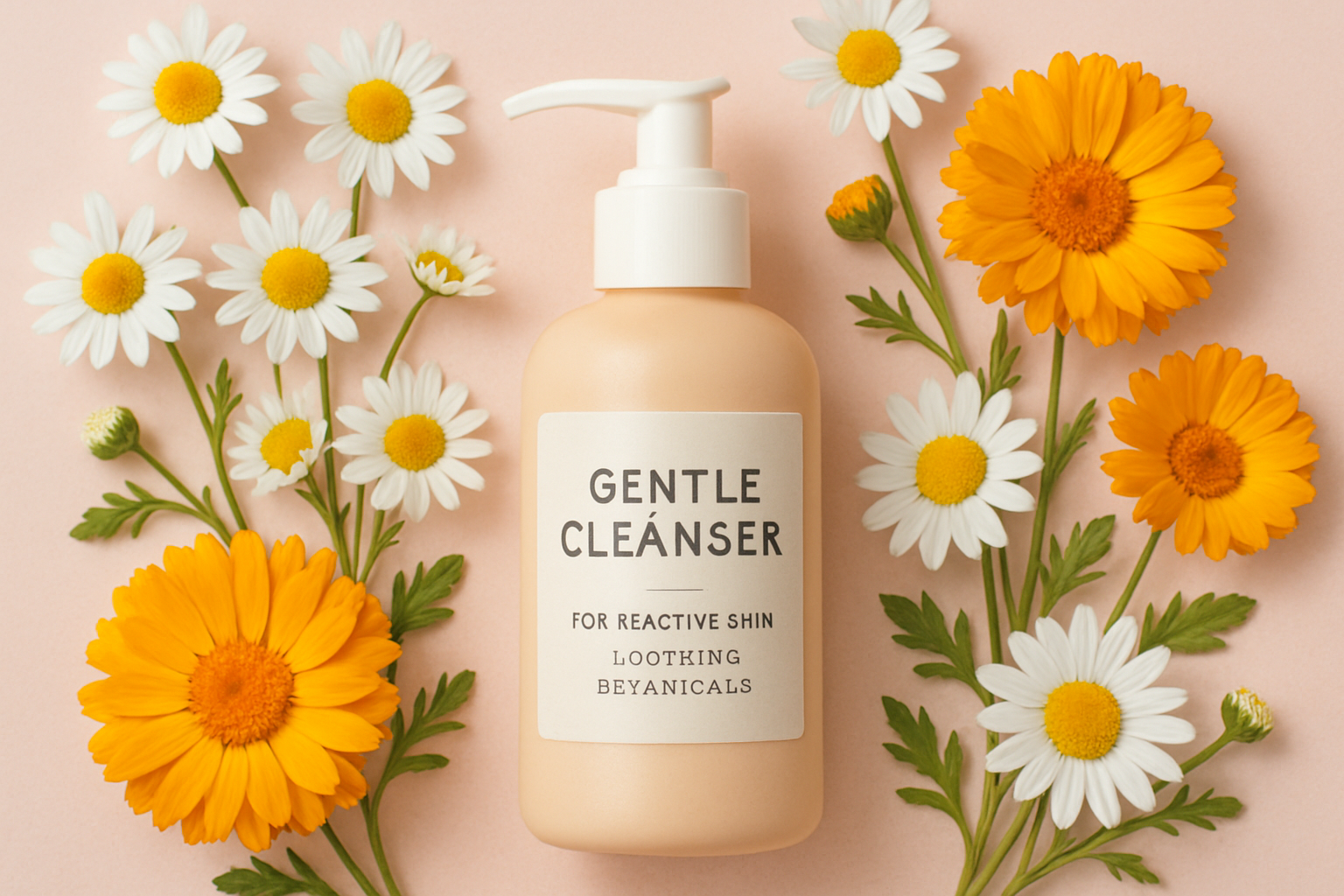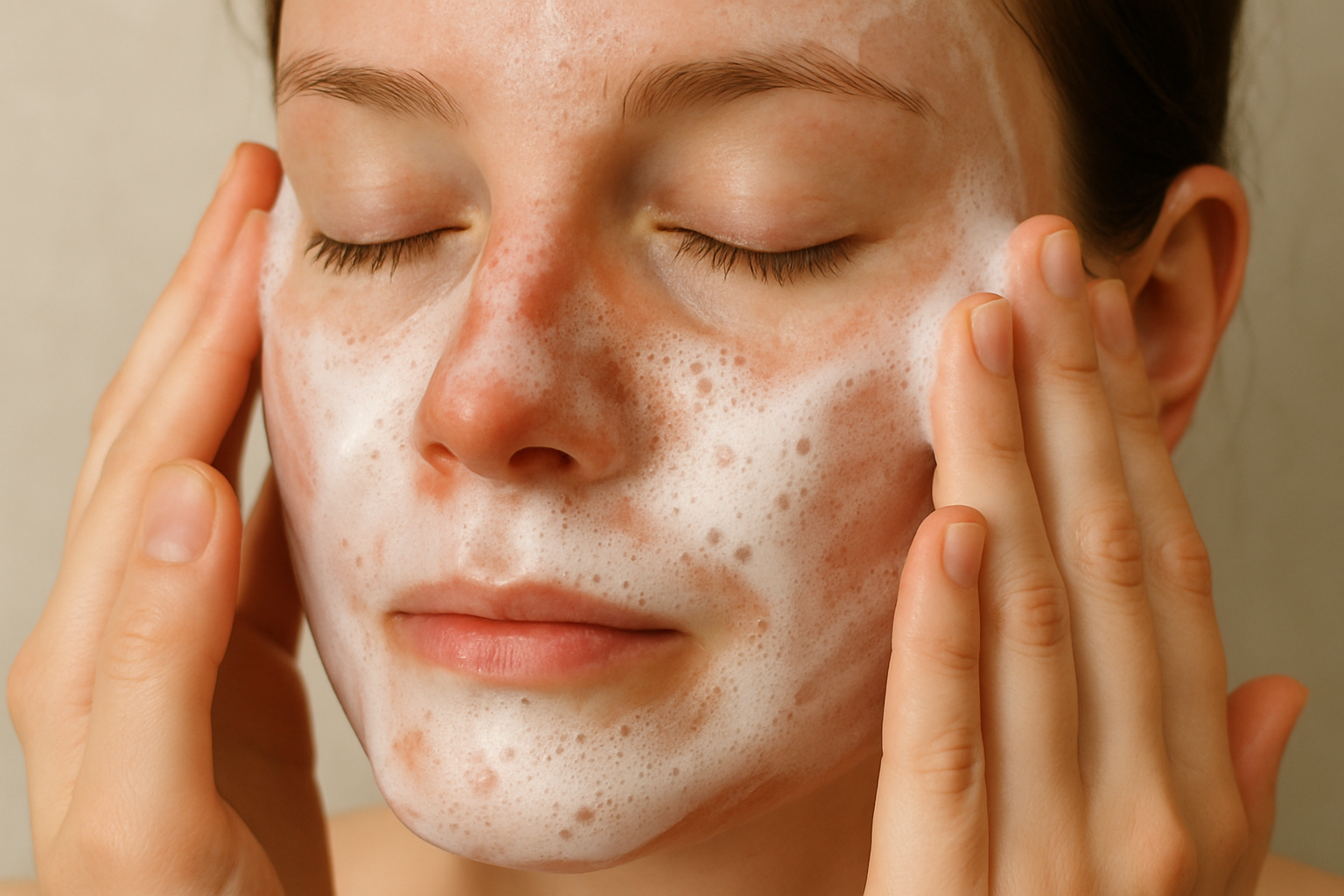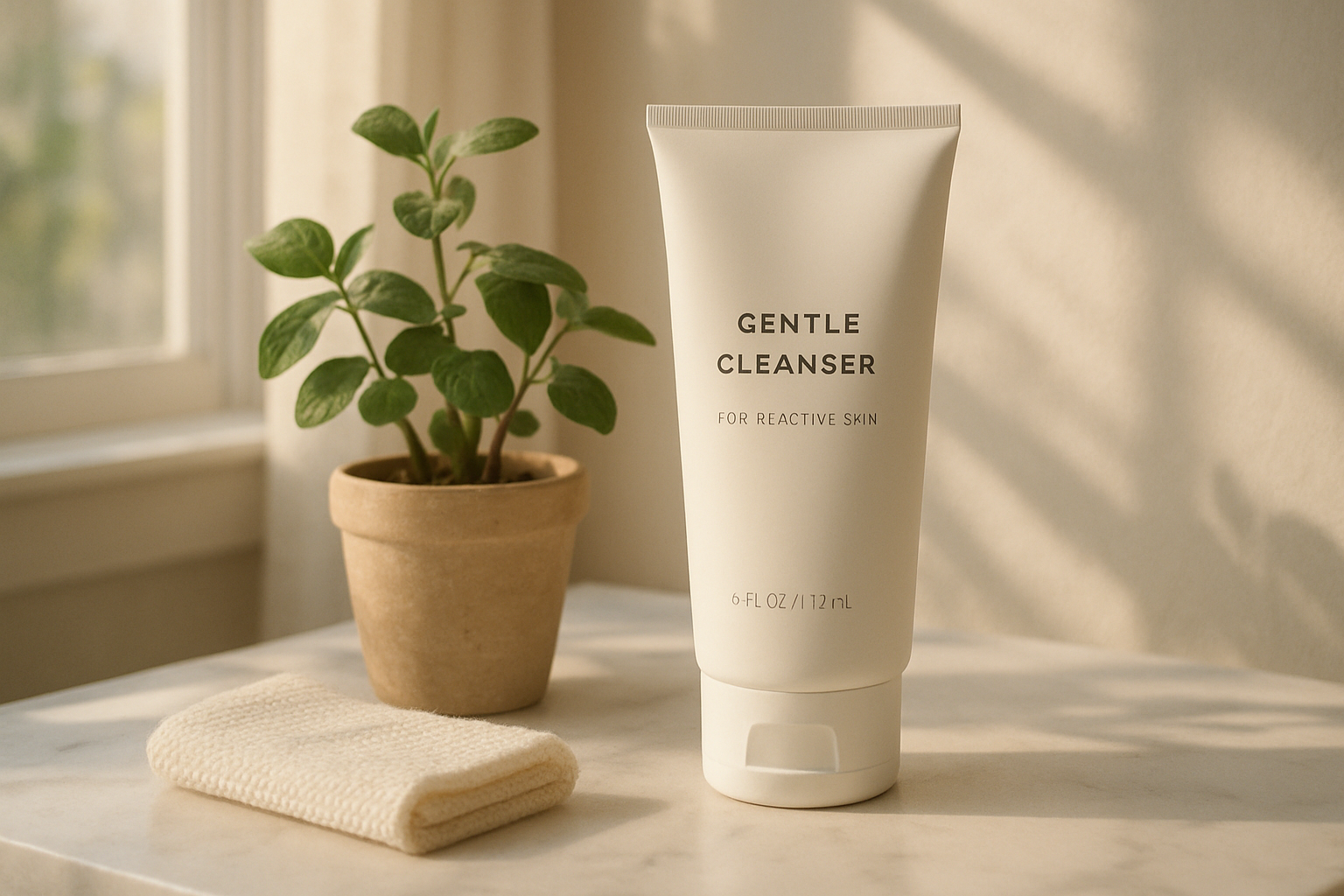
Choosing the Perfect Gentle Cleanser for Reactive Skin: Expert Tips and Trusted Solutions
Share
It’s no secret that reactive skin demands gentle care every time you cleanse.
But what exactly makes a cleanser truly gentle for this sensitive skin type?
Here’s a detailed cheatsheet to navigate the best gentle cleansers for reactive skin.
Some are formulated with breakthrough soothing ingredients like ceramides and niacinamide.
Some avoid common irritants such as fragrances, parabens, and sulfates entirely.
Some offer nourishing hydration alongside effective cleansing.
Some come with certifications ensuring they are vegan, cruelty-free, and organic.
Some support sustainable packaging and ethical production—values important for sensitive skin and planet lovers alike.
Let's dive right in.
Why Choose a Gentle Cleanser for Reactive Skin?
Reactive skin is more prone to redness, tightness, irritation, and sometimes even inflammation when exposed to harsh ingredients or environmental factors. Using a harsh cleanser can strip away natural oils and damage the skin’s protective barrier, exacerbating sensitivity. The key is to cleanse effectively without compromising the skin’s delicate balance.
Gentle cleansers maintain hydration and reinforce the skin barrier using soothing, skin-loving ingredients. They help remove impurities, makeup, and pollution without triggering flare-ups or discomfort.
For example, formulations enriched with ceramides and niacinamide support the skin’s natural defence mechanisms, enhancing resilience to irritants. Hydrating agents like glycerin and hyaluronic acid bind moisture, preventing dryness after cleansing.
This aligns perfectly with the philosophy of vegan and organic skincare, which prioritises purity and transparency to offer safe, effective solutions — especially important for reactive skin types.
Tip: Always look for cleansers labelled fragrance-free and formulated without parabens, sulfates, or other common irritants to keep your skin calm and balanced.
Key Ingredients to Look for in Gentle Cleansers
When choosing a gentle cleanser for reactive skin, ingredient choice is paramount. Here are some science-backed ingredients that soothe, protect, and nourish the delicate epidermis:
- Ceramides: Lipids that restore the skin barrier and lock in moisture.
- Niacinamide: An anti-inflammatory that reduces redness and strengthens skin.
- Glycerin & Hyaluronic Acid: Potent humectants that maintain hydration during and after cleansing.
- Ectoin: A natural molecule that protects skin from stress and calms irritation, increasingly popular in sensitive skin formulas (source).
- Aloe Vera & Cucumber Extract: Botanical soothers known for their calming properties.
- Oat Kernel Extract: Contains anti-itch and anti-inflammatory benefits, perfect for redness-prone skin.
- Chamomile & Calendula: Gentle botanicals that support skin comfort and reduce inflammation.
Avoid ingredients like fragrances, parabens, sulfates (eg: sodium lauryl sulfate), alcohols, and certain preservatives that commonly aggravate reactive skin.
Top Trusted Gentle Cleansers for Reactive Skin
There’s an increasing number of cleansers that marry gentle formulations with high-performance results. Here are some standout examples backed by dermatologists and customer accolades:
La Roche-Posay Toleriane Hydrating Gentle Cleanser
Recommended by board-certified dermatologists for sensitive skin, this creamy, soap-free cleanser contains ceramides, niacinamide, glycerin, and prebiotic thermal water to soothe and hydrate without stripping natural oils. It effortlessly removes impurities and makeup, ideal for those prone to redness and dryness (source).
Skinfix Barrier+ Ceramide + Ectoin Hydrating Gentle Gel Cleanser
This innovative gel-to-foam cleanser harnesses ectoin, a potent natural moisture binder, along with ceramides to protect and smooth reactive skin. It comforts and replenishes the skin barrier while effectively cleansing (source).
Dermalogica Ultracalming Cleanser
Formulated with oat kernel and lavender extracts, this gel-based cleanser is designed specifically for sensitive and redness-prone complexions. It calms, soothes, and restores moisture balance without harsh chemicals or fragrances (source).
Bioderma Sensibio Micellar Cleansing Oil
Designed for reactive skin, Bioderma's micellar cleansing oil transforms into a milky lotion to deeply cleanse while reinforcing skin hydration with omega fatty acids. It’s gentle enough for daily use and removes waterproof makeup effectively.
Lulumine Sensitive Face & Body Cleanser
Crafted with over 90% organic ingredients and rigorously COSMOS certified, this vegan and cruelty-free cleanser combines effective hydration with gentle cleansing. It is fragrance-free and enriched with calming botanicals made for reactive skin’s delicate needs. Its sustainable packaging reflects the brand’s commitment to eco-conscious beauty.

How to Use a Gentle Cleanser for Best Results on Reactive Skin
Cleansing with care is as vital as the product you choose. Follow these steps for the most calming and effective experience:
- Start with lukewarm water: Hot water can strip natural oils and worsen sensitivity.
- Apply a small amount: Use gentle fingertips to massage the cleanser in circular motions. Avoid harsh rubbing.
- Be mindful of makeup: If you wear heavy or waterproof products, consider double cleansing with a mild oil first.
- Rinse thoroughly but gently: Use clean, lukewarm water to avoid residue.
- Pat dry: Use a soft, clean towel and avoid rubbing your face.
- Follow with soothing moisturiser: Seal in hydration to support the skin barrier (internal link).
Did you know? Sensitive skin can become sensitive due to external factors such as pollution and climate changes. Using a gentle cleanser consistently helps maintain resilience over time.
Common Mistakes When Choosing a Cleanser for Reactive Skin
Choosing the wrong cleanser can exacerbate reactivity. Here are mistakes to avoid:
- Picking products with fragrance or dyes: Even small amounts can trigger redness or itching.
- Using exfoliating cleansers daily: Ingredients like glycolic or salicylic acid can aggravate already reactive skin.
- Ignoring hydration: A cleanser that strips moisture leads to compromised barrier function.
- Relying on harsh foaming agents: Sulfates like sodium lauryl sulfate disrupt lipid balance and cause dryness.
- Not patch testing new products: Always try a new cleanser on a small area before full-face use.
By being mindful, you can select a cleanser that calms and nurtures without shock or discomfort.

How Do Vegan, Organic, and Cruelty-Free Values Enhance Gentle Cleansers?
Increasingly, consumers seek products that align with conscious values: no animal testing, responsibly sourced ingredients, and minimal environmental impact. These strategies fit naturally with gentle cleansers designed for reactive skin.
Organic ingredients reduce exposure to synthetic pesticides and irritants. Vegan formulas avoid animal-derived ingredients, which sometimes provoke sensitivities or allergic reactions. Cruelty-free certification ensures that no animals suffered in development, reflecting compassion and care.
Brands like Lulumine prioritize COSMOS certification, a gold standard that ensures high organic content and strict environmental criteria in production and packaging. This transparency means you not only treat your reactive skin with kindness but also support sustainable beauty practices.
Can a Cleanser Really Soothe Reactive Skin? Experts Speak
Dermatologists affirm that while cleansers don’t cure skin conditions, their formulation profoundly affects skin comfort and barrier health. Dr. Sejal Shah remarks that ingredients like niacinamide and ceramides restore and reduce inflammation post-cleanse (source).
Similarly, botanical extracts such as oat and lavender calm irritation, improving overall skin feel. Choosing the right cleanser is a powerful step in your skin’s healing journey, often overlooked in favour of moisturisers or treatments.
Wondering how to add gentle serums after cleansing? Learn all about layering vegan serums for sensitive skin, including timing and ingredient compatibility, to soothe redness and brighten here.
What Additional Benefits Do Gentle Cleansers Offer?
Beyond basic cleansing, well-crafted gentle cleansers often:
- Support skin barrier restoration and moisture retention.
- Reduce the appearance of redness and inflammation.
- Offer antioxidant and protective benefits to combat environmental stress.
- Enhance skin texture and smoothness with regular use.
- Prepare skin optimally for serums and moisturisers.
These benefits mean your cleanser is not only a first step in hygiene but a nourishing ritual of self-care and love.

How to Know if a Gentle Cleanser Is Right for Your Skin?
Signs your cleanser suits your reactive skin include:
- Your skin feels clean but not tight or dry.
- Redness or itching diminishes after use rather than worsens.
- Makeup and impurities are effectively removed without residue.
- Your skin appears calmer and softer with consistent use.
If you notice burning, stinging, or worsening sensitivity, discontinue immediately and consider consulting a dermatologist for personalized advice.
Can Gentle Cleansers Help with Common Skin Issues Like Redness and Flakiness?
Absolutely. Many reactive skin types struggle with symptoms triggered by disrupted skin barriers. By choosing cleansers enriched with hydrating, anti-inflammatory ingredients, you encourage barrier repair and reduce visible irritation.
Dual-action formulas that cleanse while infusing lipids or humectants can prevent the cycle of dryness followed by reactive flare-ups. Ingredients like colloidal oatmeal, licorice, and rosehip oil soothe and calm while protecting against environmental aggressors.
This holistic approach to cleansing turns a simple daily habit into therapeutic self-care.
Tips for Selecting the Best Gentle Cleanser for Reactive Skin
- Choose fragrance-free: Even naturally derived fragrances can trigger reactions.
- Check for organic certifications: Brands holding COSMOS or Ecocert seals guarantee high-quality, skin-friendly ingredients.
- Look for multi-functional benefits: Hydration, barrier support, and anti-inflammatory properties combined with cleansing.
- Read customer reviews: Real-world testimonials provide insights on efficacy and tolerance.
- Buy smaller sizes first: Patch test before committing to full-size products.
- Prefer sustainable packaging: Supports ethical consumption and reduces environmental impact.
How to Transition to a New Gentle Cleanser with Reactive Skin
Introducing any new skincare product to reactive skin requires gentleness and patience.
Start by applying the new cleanser once daily, preferably in the evening, while maintaining your regular morning routine. Gradually increase to twice daily over 1-2 weeks as tolerated. Monitor your skin’s response carefully; any irritation or worsening redness is a sign to reduce frequency or discontinue.
Following cleansing, soothe your skin with barrier-supporting moisturisers and serums. The combination sets the stage for reduced sensitivity and long-term resilience.
Frequently Asked Questions (FAQs)
What makes a cleanser suitable for reactive skin?
A cleanser suitable for reactive skin is free of irritants like fragrances, sulfates, and alcohols, and contains soothing, hydrating ingredients such as ceramides, niacinamide, and plant extracts.
Can I use a gentle cleanser if I have oily reactive skin?
Yes. Gentle cleansers can balance oil production without stripping the skin, preventing rebound dryness or inflammation. Look for formulations that cleanse effectively but maintain hydration.
How often should I cleanse reactive skin?
Twice daily cleansing – morning and evening – is generally recommended, but listen to your skin. Over-washing can cause irritation.
Are vegan and organic certifications important for sensitive skin?
They often signal clean, non-irritating formulations. Organic ingredients reduce exposure to synthetic chemicals, and vegan products avoid animal-based allergens and ethical concerns.
Can a gentle cleanser remove waterproof makeup?
Some gentle cleansers can, but often it’s better to use a dedicated oil cleanser or micellar water first, then follow with a gentle cleanser for thorough removal.
Is it normal for reactive skin to feel tight after cleansing?
Not if the cleanser is truly gentle. Tightness indicates moisture loss or barrier disruption; switch to a more hydrating formula if this occurs.
What’s the difference between sensitive and reactive skin?
Reactive skin is a subtype of sensitive skin that responds quickly and visibly to triggers such as products, weather, or stress, often with redness or irritation.
What's Your Next Step?
Tell us in the comments: How will you apply this to your skincare routine? For personalised advice, discover our guide to organic moisturisers for sensitive skin and take your self-care to the next level.
(Verified with sources as of 2025-09-01)
